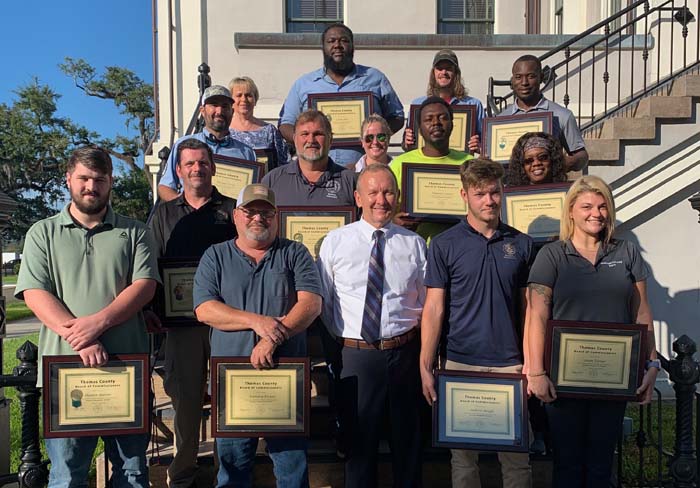County Commissioners award Deming Orientation Group 29
Published 10:06 am Tuesday, September 12, 2023

- READY TO BE MODEL MANAGERS: Pictured left to right, 1st Row: Hunter Baxter, 911; Anthony Pickels, Public Works; Mike Stephenson, County Manager; Andrew Baugh, Facilities Management; Susan Turner, 911. 2nd Row: Elbert Willis, Facilities Management; Leslie Clark, Planning & Inspections; Damian Cooper, Public Works; Kesha Walker, Facilities Management. 3rd Row: Michael Horne, Public Works; Celia Smith, Ranges @ Oakfield; 4th Row: Mary Griffin, Commissioners’ Office; Casey Spry, Public Works; Josh Henderson, Public Works; Marcus Paytee, Facilities Management.
THOMASVILLE- The Thomas County Board of Commissioners met on Tuesday morning, where they awarded Deming Orientation Group 29 with framed certificates.
The group, consisting of 21 individuals, meets for 10 weeks and follows the Deming Management Method.
Trending
The Deming Management Method teaches students that great management can be reached by following three simple steps: quality input, process management and empowering employees.
Under the first step of quality input, students learned there are five categories of inputs including, personnel, buildings, vehicles, equipment and materials/supplies.
“In order to achieve constant improvement of quality, the organization must be viewed as a system, made up of many, many processes,” said County Administrator Mike Stephenson at orientation. “Each process is made up of inputs and quality improvement begins at the input level. As the quality of inputs are improved, the quality of product delivered to the customer will improve.
A failure to maximize the quality of inputs into the product, results in a degraded product output and ultimately a loss in quality customers Stephenson reminded the group.
After spending several weeks focusing on quality input, the group then turned their attention to process management. The type of process management taught in the Deming Management Method is heavily dependent on worker input and participation.
When learning about process management, there are four steps one must go through, beginning with process initialization.
Trending
“At the beginning we determine who owns the process,” Stephenson said. “The owner of the entity is the entity accountable for the functioning and performance of a process and has the authority to make changes.”
After the process initialization, students can begin to define the process, meaning they can communicate operational details to those involved in the process and provide a baseline or standard for evaluation and improvement.
Once everyone understands their duty, students learned how to best measure the operation through the action of process control.
“Process control is achieved when points of control are established; operational measurements are implemented; and means for regulating feedback and correction are in place,” Stephenson explained.
Finally, students can then analyze the process.
Analyzing the process requires students to describe the inputs and outputs, list the task in each major activity, classify the task, determine the task cost and evaluate the cost as relative to the quality of the output.
After weeks of working on process management, the students completed the Deming Model Management course by learning how to empower employees.
The model offered eight possibilities for empowering staff, including transforming management by dismantling existing structures, management leading the way by removing obstacles, instituting training, developing and encouraging teamwork, driving out management by fear, breaking down barriers between departments, eliminating performance rating because they build fear and removing barriers to pride in workmanship.
With all this new information on best management practices, students began work at their new Thomas County job location, ready to improve their skillset and leadership in the workplace.





